Cosmetics Market Report: Buying Behavior, Segmentation & Strategy
VerifiedAdded on 2023/06/23
|23
|6966
|172
Report
AI Summary
This report provides a detailed analysis of the cosmetics market, focusing on consumer buying behavior and market segmentation strategies. It examines how a company influences customers to purchase products by understanding the buying behavior model, including need recognition, information search, evaluation of alternatives, purchase decision, and post-purchase behavior. The report identifies segmentation variables such as geographic, demographic, behavioral, and psychological factors used to segment the market effectively. It also identifies the targeting strategy employed and analyzes the positioning bases used to create a specific image in the customer's mind. Furthermore, the marketing mix is analyzed by identifying the types of features added to the product, the pricing strategy, the distribution strategy, and the promotional tools used to reach customers. The analysis provides a comprehensive understanding of the strategies employed in the cosmetics market.
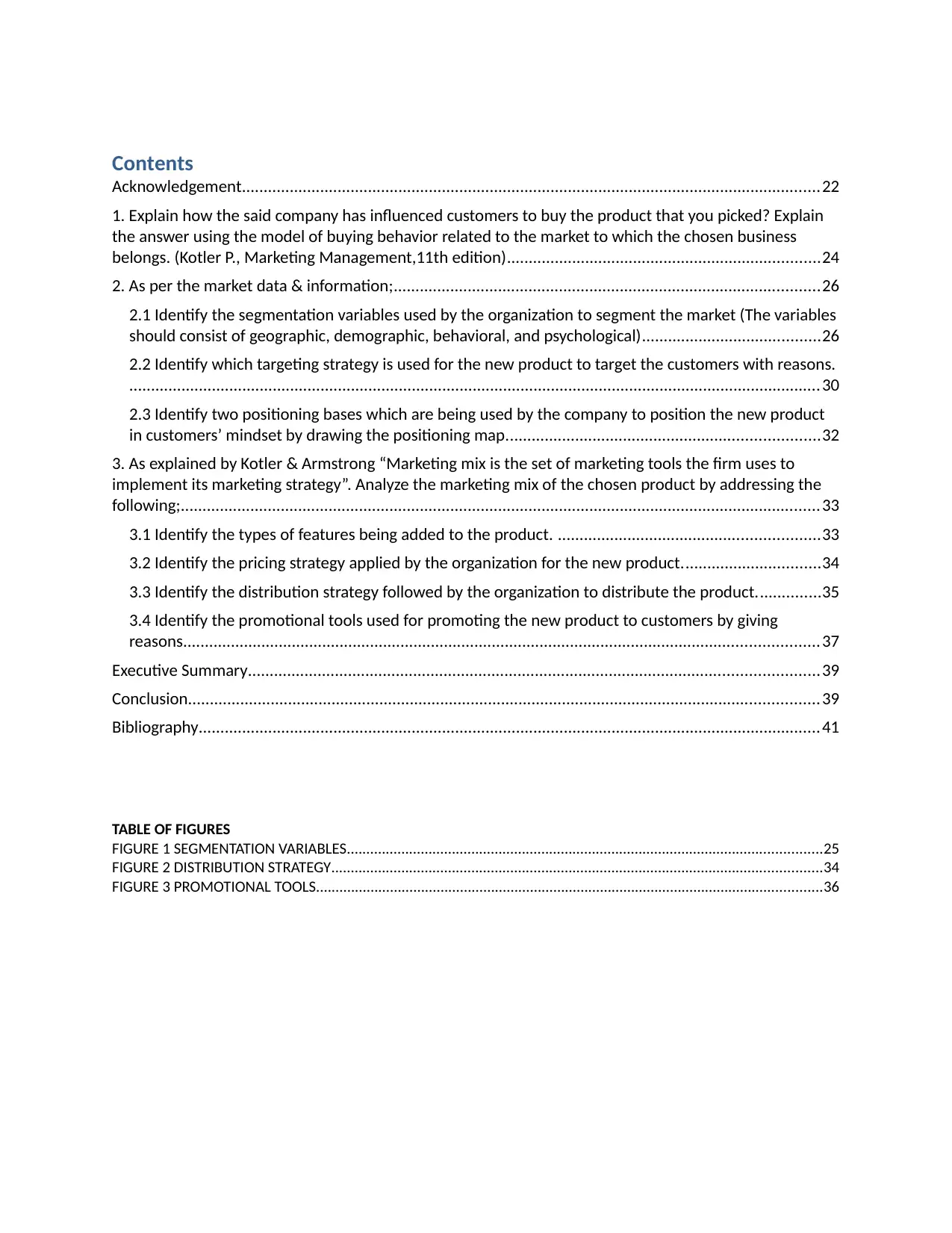
Contents
Acknowledgement.....................................................................................................................................22
1. Explain how the said company has influenced customers to buy the product that you picked? Explain
the answer using the model of buying behavior related to the market to which the chosen business
belongs. (Kotler P., Marketing Management,11th edition)........................................................................24
2. As per the market data & information;..................................................................................................26
2.1 Identify the segmentation variables used by the organization to segment the market (The variables
should consist of geographic, demographic, behavioral, and psychological).........................................26
2.2 Identify which targeting strategy is used for the new product to target the customers with reasons.
...............................................................................................................................................................30
2.3 Identify two positioning bases which are being used by the company to position the new product
in customers’ mindset by drawing the positioning map........................................................................32
3. As explained by Kotler & Armstrong “Marketing mix is the set of marketing tools the firm uses to
implement its marketing strategy”. Analyze the marketing mix of the chosen product by addressing the
following;...................................................................................................................................................33
3.1 Identify the types of features being added to the product. ............................................................33
3.2 Identify the pricing strategy applied by the organization for the new product................................34
3.3 Identify the distribution strategy followed by the organization to distribute the product...............35
3.4 Identify the promotional tools used for promoting the new product to customers by giving
reasons..................................................................................................................................................37
Executive Summary...................................................................................................................................39
Conclusion.................................................................................................................................................39
Bibliography...............................................................................................................................................41
TABLE OF FIGURES
FIGURE 1 SEGMENTATION VARIABLES..........................................................................................................................25
FIGURE 2 DISTRIBUTION STRATEGY..............................................................................................................................34
FIGURE 3 PROMOTIONAL TOOLS..................................................................................................................................36
Acknowledgement.....................................................................................................................................22
1. Explain how the said company has influenced customers to buy the product that you picked? Explain
the answer using the model of buying behavior related to the market to which the chosen business
belongs. (Kotler P., Marketing Management,11th edition)........................................................................24
2. As per the market data & information;..................................................................................................26
2.1 Identify the segmentation variables used by the organization to segment the market (The variables
should consist of geographic, demographic, behavioral, and psychological).........................................26
2.2 Identify which targeting strategy is used for the new product to target the customers with reasons.
...............................................................................................................................................................30
2.3 Identify two positioning bases which are being used by the company to position the new product
in customers’ mindset by drawing the positioning map........................................................................32
3. As explained by Kotler & Armstrong “Marketing mix is the set of marketing tools the firm uses to
implement its marketing strategy”. Analyze the marketing mix of the chosen product by addressing the
following;...................................................................................................................................................33
3.1 Identify the types of features being added to the product. ............................................................33
3.2 Identify the pricing strategy applied by the organization for the new product................................34
3.3 Identify the distribution strategy followed by the organization to distribute the product...............35
3.4 Identify the promotional tools used for promoting the new product to customers by giving
reasons..................................................................................................................................................37
Executive Summary...................................................................................................................................39
Conclusion.................................................................................................................................................39
Bibliography...............................................................................................................................................41
TABLE OF FIGURES
FIGURE 1 SEGMENTATION VARIABLES..........................................................................................................................25
FIGURE 2 DISTRIBUTION STRATEGY..............................................................................................................................34
FIGURE 3 PROMOTIONAL TOOLS..................................................................................................................................36
Paraphrase This Document
Need a fresh take? Get an instant paraphrase of this document with our AI Paraphraser
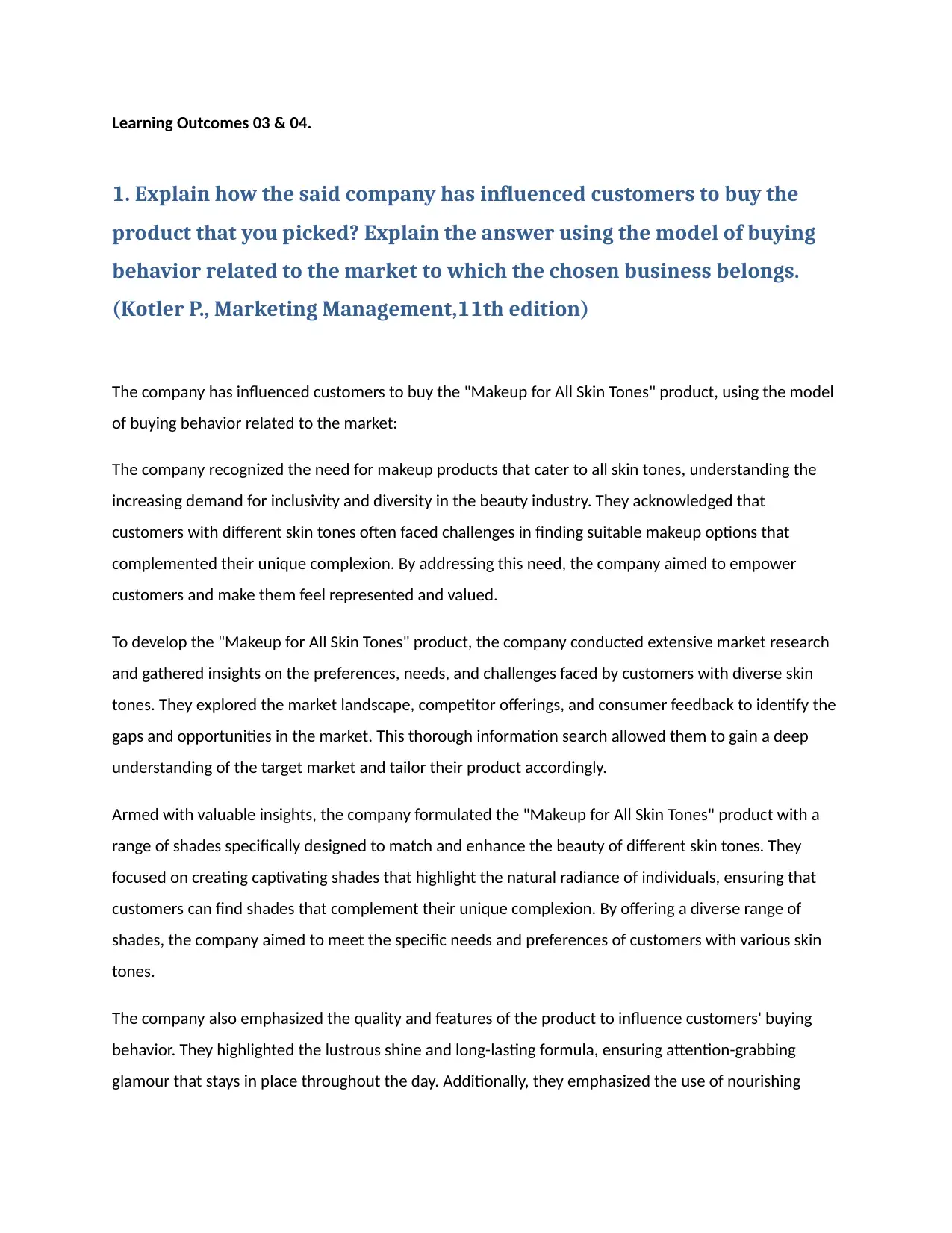
Learning Outcomes 03 & 04.
1. Explain how the said company has influenced customers to buy the
product that you picked? Explain the answer using the model of buying
behavior related to the market to which the chosen business belongs.
(Kotler P., Marketing Management,11th edition)
The company has influenced customers to buy the "Makeup for All Skin Tones" product, using the model
of buying behavior related to the market:
The company recognized the need for makeup products that cater to all skin tones, understanding the
increasing demand for inclusivity and diversity in the beauty industry. They acknowledged that
customers with different skin tones often faced challenges in finding suitable makeup options that
complemented their unique complexion. By addressing this need, the company aimed to empower
customers and make them feel represented and valued.
To develop the "Makeup for All Skin Tones" product, the company conducted extensive market research
and gathered insights on the preferences, needs, and challenges faced by customers with diverse skin
tones. They explored the market landscape, competitor offerings, and consumer feedback to identify the
gaps and opportunities in the market. This thorough information search allowed them to gain a deep
understanding of the target market and tailor their product accordingly.
Armed with valuable insights, the company formulated the "Makeup for All Skin Tones" product with a
range of shades specifically designed to match and enhance the beauty of different skin tones. They
focused on creating captivating shades that highlight the natural radiance of individuals, ensuring that
customers can find shades that complement their unique complexion. By offering a diverse range of
shades, the company aimed to meet the specific needs and preferences of customers with various skin
tones.
The company also emphasized the quality and features of the product to influence customers' buying
behavior. They highlighted the lustrous shine and long-lasting formula, ensuring attention-grabbing
glamour that stays in place throughout the day. Additionally, they emphasized the use of nourishing
1. Explain how the said company has influenced customers to buy the
product that you picked? Explain the answer using the model of buying
behavior related to the market to which the chosen business belongs.
(Kotler P., Marketing Management,11th edition)
The company has influenced customers to buy the "Makeup for All Skin Tones" product, using the model
of buying behavior related to the market:
The company recognized the need for makeup products that cater to all skin tones, understanding the
increasing demand for inclusivity and diversity in the beauty industry. They acknowledged that
customers with different skin tones often faced challenges in finding suitable makeup options that
complemented their unique complexion. By addressing this need, the company aimed to empower
customers and make them feel represented and valued.
To develop the "Makeup for All Skin Tones" product, the company conducted extensive market research
and gathered insights on the preferences, needs, and challenges faced by customers with diverse skin
tones. They explored the market landscape, competitor offerings, and consumer feedback to identify the
gaps and opportunities in the market. This thorough information search allowed them to gain a deep
understanding of the target market and tailor their product accordingly.
Armed with valuable insights, the company formulated the "Makeup for All Skin Tones" product with a
range of shades specifically designed to match and enhance the beauty of different skin tones. They
focused on creating captivating shades that highlight the natural radiance of individuals, ensuring that
customers can find shades that complement their unique complexion. By offering a diverse range of
shades, the company aimed to meet the specific needs and preferences of customers with various skin
tones.
The company also emphasized the quality and features of the product to influence customers' buying
behavior. They highlighted the lustrous shine and long-lasting formula, ensuring attention-grabbing
glamour that stays in place throughout the day. Additionally, they emphasized the use of nourishing
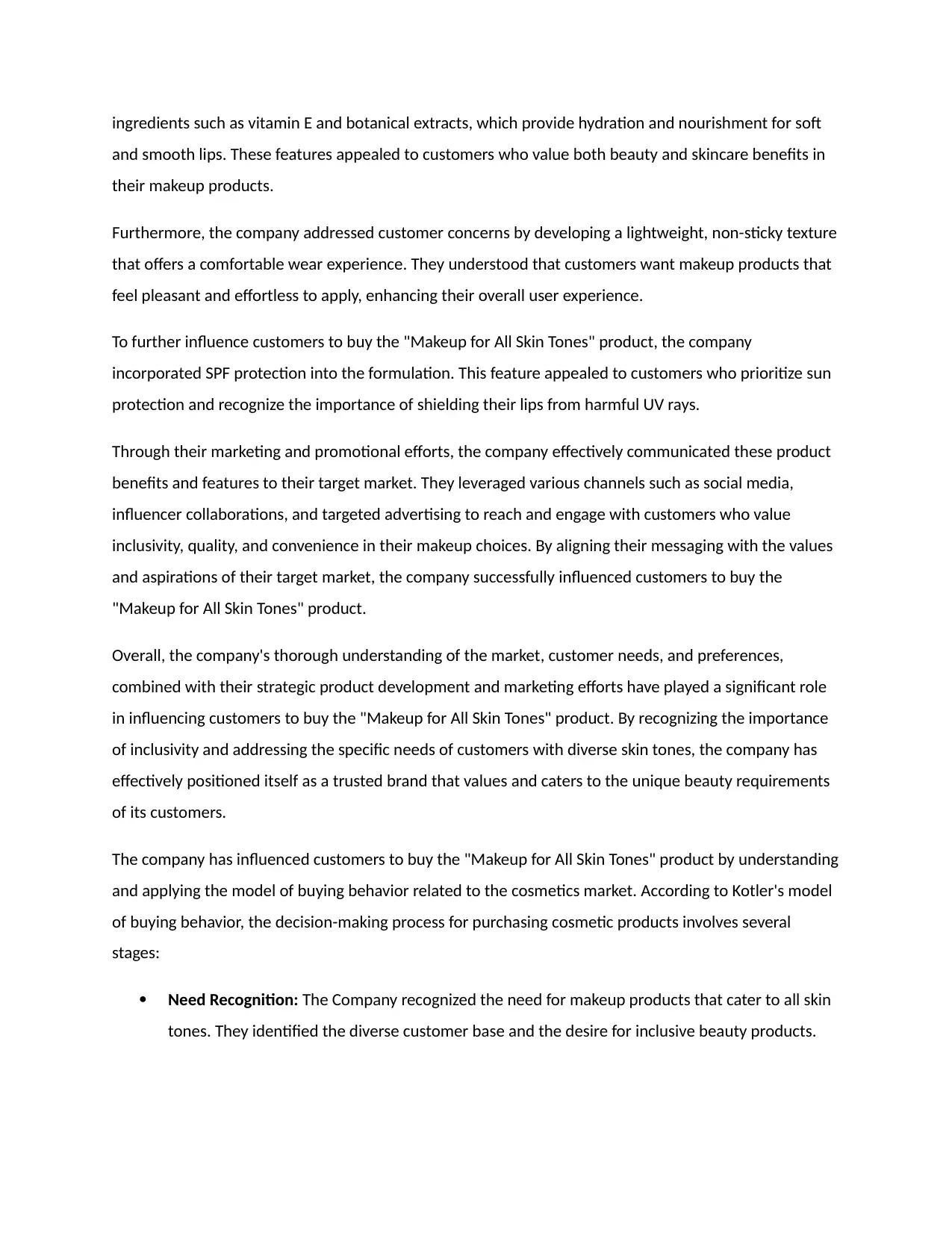
ingredients such as vitamin E and botanical extracts, which provide hydration and nourishment for soft
and smooth lips. These features appealed to customers who value both beauty and skincare benefits in
their makeup products.
Furthermore, the company addressed customer concerns by developing a lightweight, non-sticky texture
that offers a comfortable wear experience. They understood that customers want makeup products that
feel pleasant and effortless to apply, enhancing their overall user experience.
To further influence customers to buy the "Makeup for All Skin Tones" product, the company
incorporated SPF protection into the formulation. This feature appealed to customers who prioritize sun
protection and recognize the importance of shielding their lips from harmful UV rays.
Through their marketing and promotional efforts, the company effectively communicated these product
benefits and features to their target market. They leveraged various channels such as social media,
influencer collaborations, and targeted advertising to reach and engage with customers who value
inclusivity, quality, and convenience in their makeup choices. By aligning their messaging with the values
and aspirations of their target market, the company successfully influenced customers to buy the
"Makeup for All Skin Tones" product.
Overall, the company's thorough understanding of the market, customer needs, and preferences,
combined with their strategic product development and marketing efforts have played a significant role
in influencing customers to buy the "Makeup for All Skin Tones" product. By recognizing the importance
of inclusivity and addressing the specific needs of customers with diverse skin tones, the company has
effectively positioned itself as a trusted brand that values and caters to the unique beauty requirements
of its customers.
The company has influenced customers to buy the "Makeup for All Skin Tones" product by understanding
and applying the model of buying behavior related to the cosmetics market. According to Kotler's model
of buying behavior, the decision-making process for purchasing cosmetic products involves several
stages:
Need Recognition: The Company recognized the need for makeup products that cater to all skin
tones. They identified the diverse customer base and the desire for inclusive beauty products.
and smooth lips. These features appealed to customers who value both beauty and skincare benefits in
their makeup products.
Furthermore, the company addressed customer concerns by developing a lightweight, non-sticky texture
that offers a comfortable wear experience. They understood that customers want makeup products that
feel pleasant and effortless to apply, enhancing their overall user experience.
To further influence customers to buy the "Makeup for All Skin Tones" product, the company
incorporated SPF protection into the formulation. This feature appealed to customers who prioritize sun
protection and recognize the importance of shielding their lips from harmful UV rays.
Through their marketing and promotional efforts, the company effectively communicated these product
benefits and features to their target market. They leveraged various channels such as social media,
influencer collaborations, and targeted advertising to reach and engage with customers who value
inclusivity, quality, and convenience in their makeup choices. By aligning their messaging with the values
and aspirations of their target market, the company successfully influenced customers to buy the
"Makeup for All Skin Tones" product.
Overall, the company's thorough understanding of the market, customer needs, and preferences,
combined with their strategic product development and marketing efforts have played a significant role
in influencing customers to buy the "Makeup for All Skin Tones" product. By recognizing the importance
of inclusivity and addressing the specific needs of customers with diverse skin tones, the company has
effectively positioned itself as a trusted brand that values and caters to the unique beauty requirements
of its customers.
The company has influenced customers to buy the "Makeup for All Skin Tones" product by understanding
and applying the model of buying behavior related to the cosmetics market. According to Kotler's model
of buying behavior, the decision-making process for purchasing cosmetic products involves several
stages:
Need Recognition: The Company recognized the need for makeup products that cater to all skin
tones. They identified the diverse customer base and the desire for inclusive beauty products.
⊘ This is a preview!⊘
Do you want full access?
Subscribe today to unlock all pages.

Trusted by 1+ million students worldwide
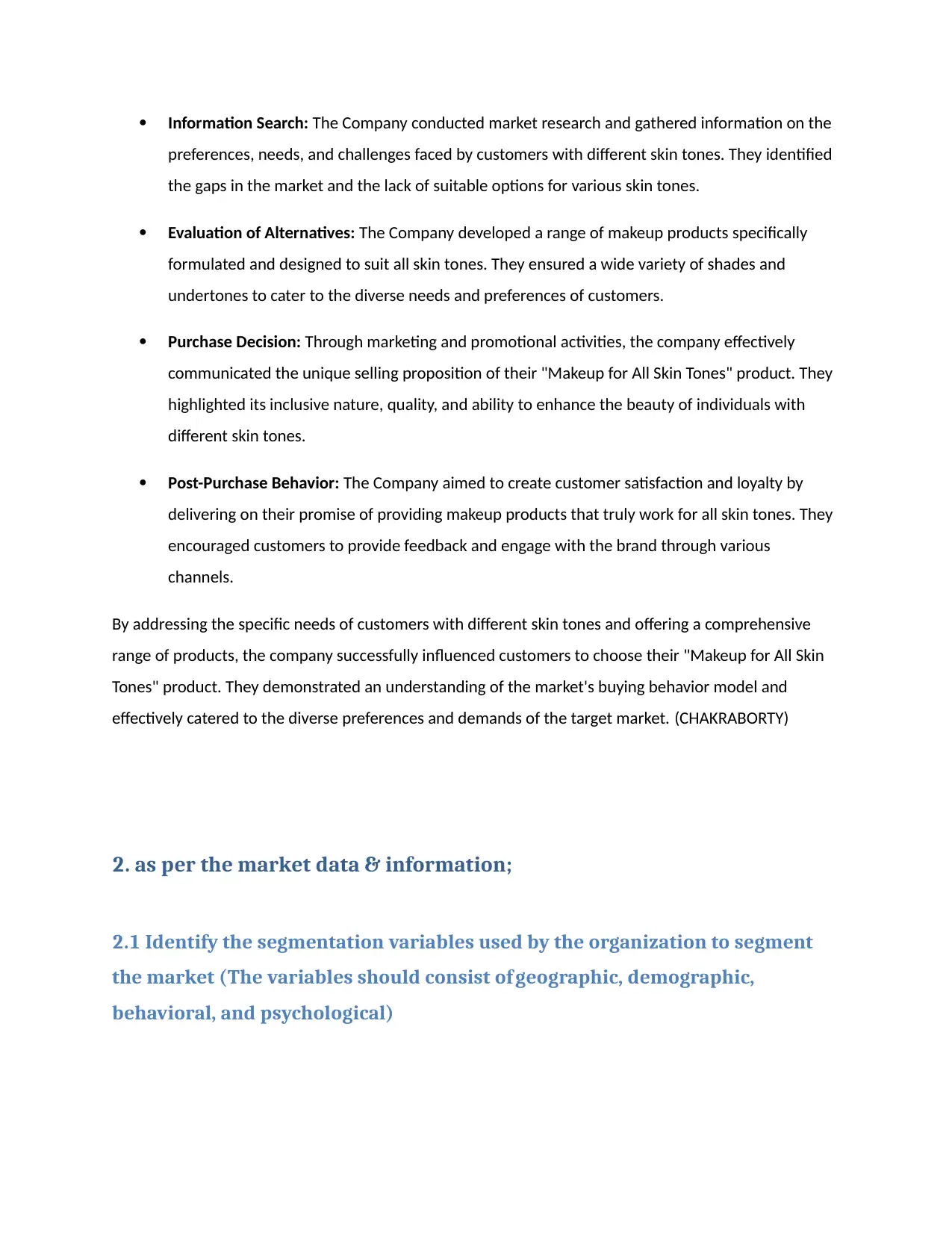
Information Search: The Company conducted market research and gathered information on the
preferences, needs, and challenges faced by customers with different skin tones. They identified
the gaps in the market and the lack of suitable options for various skin tones.
Evaluation of Alternatives: The Company developed a range of makeup products specifically
formulated and designed to suit all skin tones. They ensured a wide variety of shades and
undertones to cater to the diverse needs and preferences of customers.
Purchase Decision: Through marketing and promotional activities, the company effectively
communicated the unique selling proposition of their "Makeup for All Skin Tones" product. They
highlighted its inclusive nature, quality, and ability to enhance the beauty of individuals with
different skin tones.
Post-Purchase Behavior: The Company aimed to create customer satisfaction and loyalty by
delivering on their promise of providing makeup products that truly work for all skin tones. They
encouraged customers to provide feedback and engage with the brand through various
channels.
By addressing the specific needs of customers with different skin tones and offering a comprehensive
range of products, the company successfully influenced customers to choose their "Makeup for All Skin
Tones" product. They demonstrated an understanding of the market's buying behavior model and
effectively catered to the diverse preferences and demands of the target market. (CHAKRABORTY)
2. as per the market data & information;
2.1 Identify the segmentation variables used by the organization to segment
the market (The variables should consist of geographic, demographic,
behavioral, and psychological)
preferences, needs, and challenges faced by customers with different skin tones. They identified
the gaps in the market and the lack of suitable options for various skin tones.
Evaluation of Alternatives: The Company developed a range of makeup products specifically
formulated and designed to suit all skin tones. They ensured a wide variety of shades and
undertones to cater to the diverse needs and preferences of customers.
Purchase Decision: Through marketing and promotional activities, the company effectively
communicated the unique selling proposition of their "Makeup for All Skin Tones" product. They
highlighted its inclusive nature, quality, and ability to enhance the beauty of individuals with
different skin tones.
Post-Purchase Behavior: The Company aimed to create customer satisfaction and loyalty by
delivering on their promise of providing makeup products that truly work for all skin tones. They
encouraged customers to provide feedback and engage with the brand through various
channels.
By addressing the specific needs of customers with different skin tones and offering a comprehensive
range of products, the company successfully influenced customers to choose their "Makeup for All Skin
Tones" product. They demonstrated an understanding of the market's buying behavior model and
effectively catered to the diverse preferences and demands of the target market. (CHAKRABORTY)
2. as per the market data & information;
2.1 Identify the segmentation variables used by the organization to segment
the market (The variables should consist of geographic, demographic,
behavioral, and psychological)
Paraphrase This Document
Need a fresh take? Get an instant paraphrase of this document with our AI Paraphraser
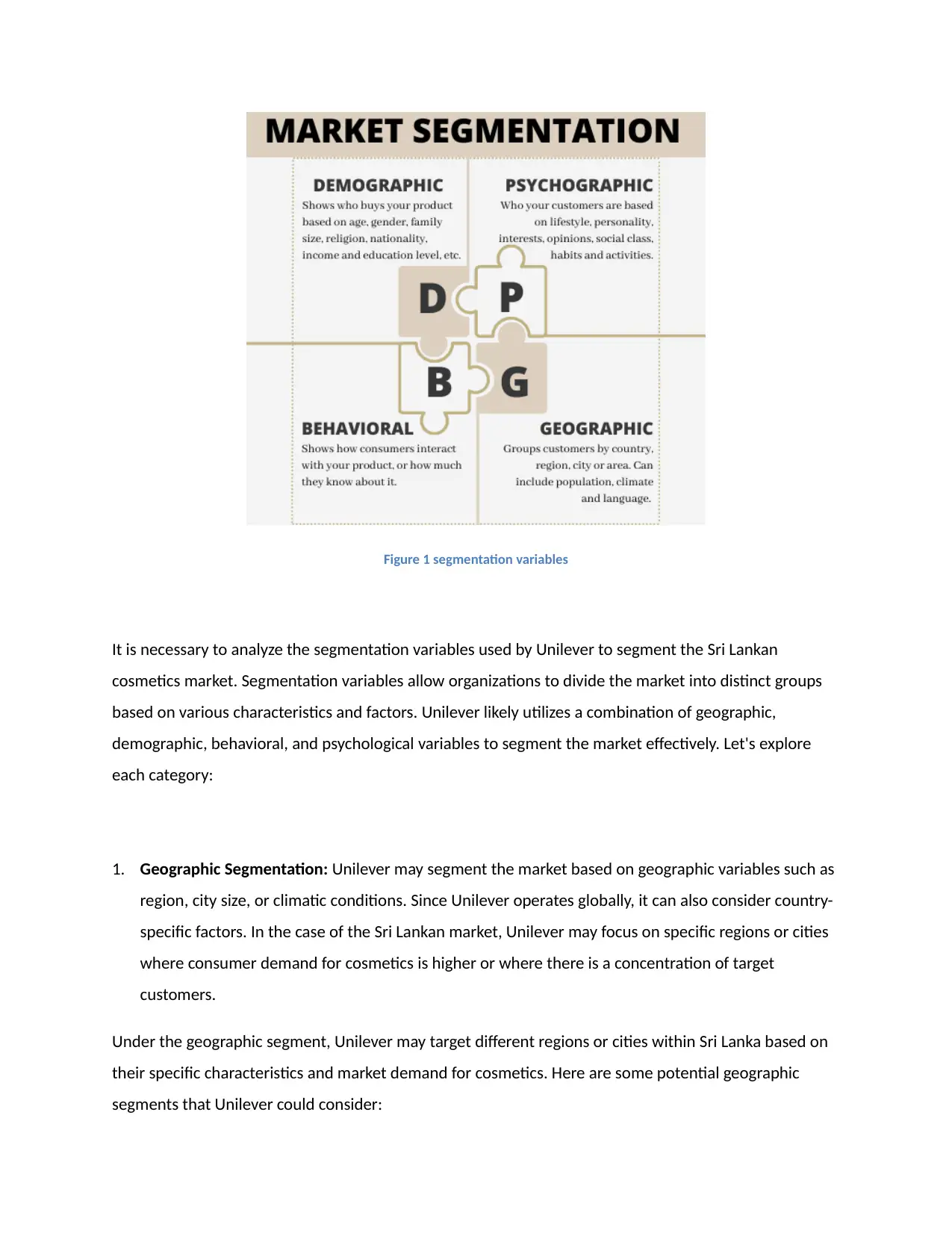
Figure 1 segmentation variables
It is necessary to analyze the segmentation variables used by Unilever to segment the Sri Lankan
cosmetics market. Segmentation variables allow organizations to divide the market into distinct groups
based on various characteristics and factors. Unilever likely utilizes a combination of geographic,
demographic, behavioral, and psychological variables to segment the market effectively. Let's explore
each category:
1. Geographic Segmentation: Unilever may segment the market based on geographic variables such as
region, city size, or climatic conditions. Since Unilever operates globally, it can also consider country-
specific factors. In the case of the Sri Lankan market, Unilever may focus on specific regions or cities
where consumer demand for cosmetics is higher or where there is a concentration of target
customers.
Under the geographic segment, Unilever may target different regions or cities within Sri Lanka based on
their specific characteristics and market demand for cosmetics. Here are some potential geographic
segments that Unilever could consider:
It is necessary to analyze the segmentation variables used by Unilever to segment the Sri Lankan
cosmetics market. Segmentation variables allow organizations to divide the market into distinct groups
based on various characteristics and factors. Unilever likely utilizes a combination of geographic,
demographic, behavioral, and psychological variables to segment the market effectively. Let's explore
each category:
1. Geographic Segmentation: Unilever may segment the market based on geographic variables such as
region, city size, or climatic conditions. Since Unilever operates globally, it can also consider country-
specific factors. In the case of the Sri Lankan market, Unilever may focus on specific regions or cities
where consumer demand for cosmetics is higher or where there is a concentration of target
customers.
Under the geographic segment, Unilever may target different regions or cities within Sri Lanka based on
their specific characteristics and market demand for cosmetics. Here are some potential geographic
segments that Unilever could consider:
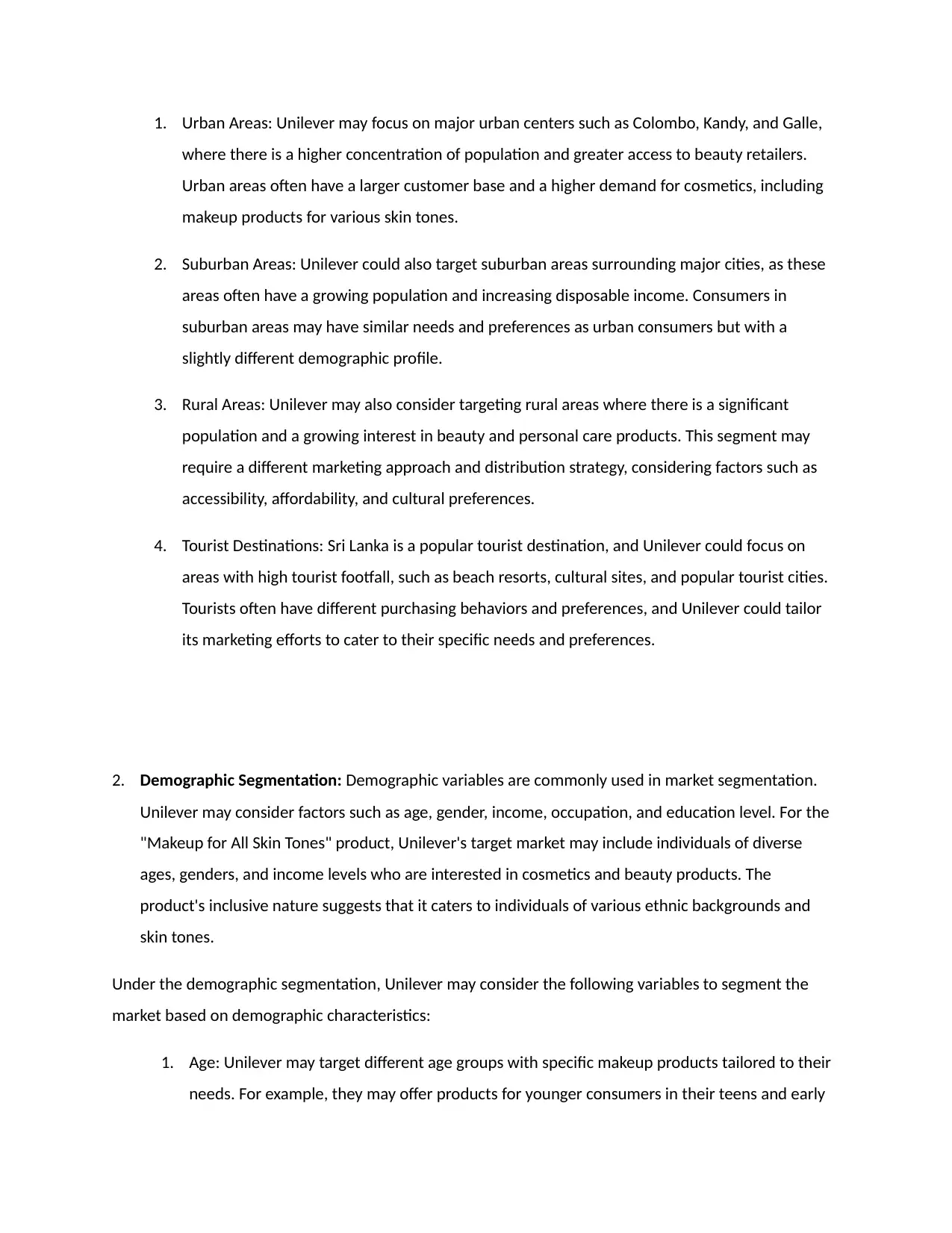
1. Urban Areas: Unilever may focus on major urban centers such as Colombo, Kandy, and Galle,
where there is a higher concentration of population and greater access to beauty retailers.
Urban areas often have a larger customer base and a higher demand for cosmetics, including
makeup products for various skin tones.
2. Suburban Areas: Unilever could also target suburban areas surrounding major cities, as these
areas often have a growing population and increasing disposable income. Consumers in
suburban areas may have similar needs and preferences as urban consumers but with a
slightly different demographic profile.
3. Rural Areas: Unilever may also consider targeting rural areas where there is a significant
population and a growing interest in beauty and personal care products. This segment may
require a different marketing approach and distribution strategy, considering factors such as
accessibility, affordability, and cultural preferences.
4. Tourist Destinations: Sri Lanka is a popular tourist destination, and Unilever could focus on
areas with high tourist footfall, such as beach resorts, cultural sites, and popular tourist cities.
Tourists often have different purchasing behaviors and preferences, and Unilever could tailor
its marketing efforts to cater to their specific needs and preferences.
2. Demographic Segmentation: Demographic variables are commonly used in market segmentation.
Unilever may consider factors such as age, gender, income, occupation, and education level. For the
"Makeup for All Skin Tones" product, Unilever's target market may include individuals of diverse
ages, genders, and income levels who are interested in cosmetics and beauty products. The
product's inclusive nature suggests that it caters to individuals of various ethnic backgrounds and
skin tones.
Under the demographic segmentation, Unilever may consider the following variables to segment the
market based on demographic characteristics:
1. Age: Unilever may target different age groups with specific makeup products tailored to their
needs. For example, they may offer products for younger consumers in their teens and early
where there is a higher concentration of population and greater access to beauty retailers.
Urban areas often have a larger customer base and a higher demand for cosmetics, including
makeup products for various skin tones.
2. Suburban Areas: Unilever could also target suburban areas surrounding major cities, as these
areas often have a growing population and increasing disposable income. Consumers in
suburban areas may have similar needs and preferences as urban consumers but with a
slightly different demographic profile.
3. Rural Areas: Unilever may also consider targeting rural areas where there is a significant
population and a growing interest in beauty and personal care products. This segment may
require a different marketing approach and distribution strategy, considering factors such as
accessibility, affordability, and cultural preferences.
4. Tourist Destinations: Sri Lanka is a popular tourist destination, and Unilever could focus on
areas with high tourist footfall, such as beach resorts, cultural sites, and popular tourist cities.
Tourists often have different purchasing behaviors and preferences, and Unilever could tailor
its marketing efforts to cater to their specific needs and preferences.
2. Demographic Segmentation: Demographic variables are commonly used in market segmentation.
Unilever may consider factors such as age, gender, income, occupation, and education level. For the
"Makeup for All Skin Tones" product, Unilever's target market may include individuals of diverse
ages, genders, and income levels who are interested in cosmetics and beauty products. The
product's inclusive nature suggests that it caters to individuals of various ethnic backgrounds and
skin tones.
Under the demographic segmentation, Unilever may consider the following variables to segment the
market based on demographic characteristics:
1. Age: Unilever may target different age groups with specific makeup products tailored to their
needs. For example, they may offer products for younger consumers in their teens and early
⊘ This is a preview!⊘
Do you want full access?
Subscribe today to unlock all pages.

Trusted by 1+ million students worldwide
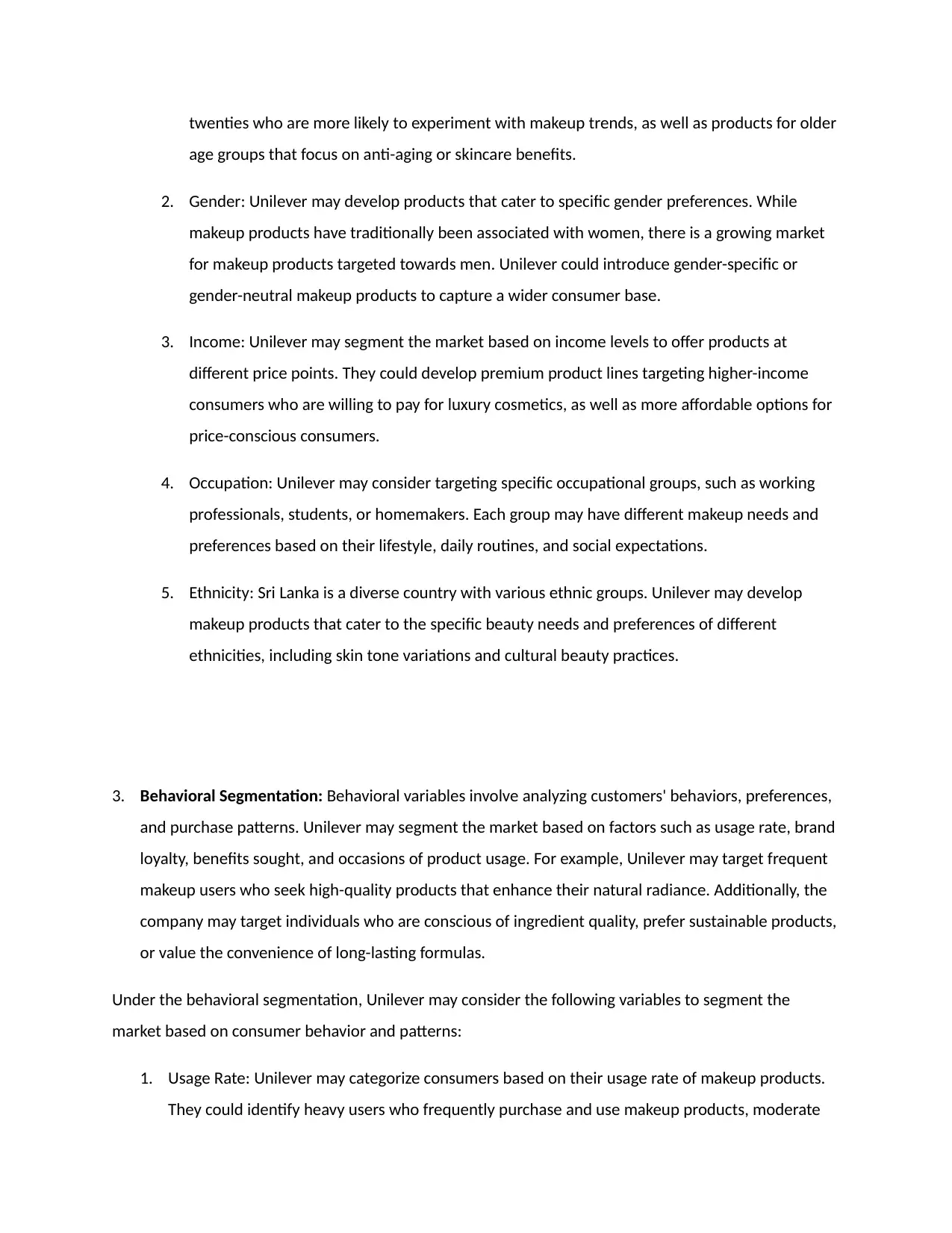
twenties who are more likely to experiment with makeup trends, as well as products for older
age groups that focus on anti-aging or skincare benefits.
2. Gender: Unilever may develop products that cater to specific gender preferences. While
makeup products have traditionally been associated with women, there is a growing market
for makeup products targeted towards men. Unilever could introduce gender-specific or
gender-neutral makeup products to capture a wider consumer base.
3. Income: Unilever may segment the market based on income levels to offer products at
different price points. They could develop premium product lines targeting higher-income
consumers who are willing to pay for luxury cosmetics, as well as more affordable options for
price-conscious consumers.
4. Occupation: Unilever may consider targeting specific occupational groups, such as working
professionals, students, or homemakers. Each group may have different makeup needs and
preferences based on their lifestyle, daily routines, and social expectations.
5. Ethnicity: Sri Lanka is a diverse country with various ethnic groups. Unilever may develop
makeup products that cater to the specific beauty needs and preferences of different
ethnicities, including skin tone variations and cultural beauty practices.
3. Behavioral Segmentation: Behavioral variables involve analyzing customers' behaviors, preferences,
and purchase patterns. Unilever may segment the market based on factors such as usage rate, brand
loyalty, benefits sought, and occasions of product usage. For example, Unilever may target frequent
makeup users who seek high-quality products that enhance their natural radiance. Additionally, the
company may target individuals who are conscious of ingredient quality, prefer sustainable products,
or value the convenience of long-lasting formulas.
Under the behavioral segmentation, Unilever may consider the following variables to segment the
market based on consumer behavior and patterns:
1. Usage Rate: Unilever may categorize consumers based on their usage rate of makeup products.
They could identify heavy users who frequently purchase and use makeup products, moderate
age groups that focus on anti-aging or skincare benefits.
2. Gender: Unilever may develop products that cater to specific gender preferences. While
makeup products have traditionally been associated with women, there is a growing market
for makeup products targeted towards men. Unilever could introduce gender-specific or
gender-neutral makeup products to capture a wider consumer base.
3. Income: Unilever may segment the market based on income levels to offer products at
different price points. They could develop premium product lines targeting higher-income
consumers who are willing to pay for luxury cosmetics, as well as more affordable options for
price-conscious consumers.
4. Occupation: Unilever may consider targeting specific occupational groups, such as working
professionals, students, or homemakers. Each group may have different makeup needs and
preferences based on their lifestyle, daily routines, and social expectations.
5. Ethnicity: Sri Lanka is a diverse country with various ethnic groups. Unilever may develop
makeup products that cater to the specific beauty needs and preferences of different
ethnicities, including skin tone variations and cultural beauty practices.
3. Behavioral Segmentation: Behavioral variables involve analyzing customers' behaviors, preferences,
and purchase patterns. Unilever may segment the market based on factors such as usage rate, brand
loyalty, benefits sought, and occasions of product usage. For example, Unilever may target frequent
makeup users who seek high-quality products that enhance their natural radiance. Additionally, the
company may target individuals who are conscious of ingredient quality, prefer sustainable products,
or value the convenience of long-lasting formulas.
Under the behavioral segmentation, Unilever may consider the following variables to segment the
market based on consumer behavior and patterns:
1. Usage Rate: Unilever may categorize consumers based on their usage rate of makeup products.
They could identify heavy users who frequently purchase and use makeup products, moderate
Paraphrase This Document
Need a fresh take? Get an instant paraphrase of this document with our AI Paraphraser
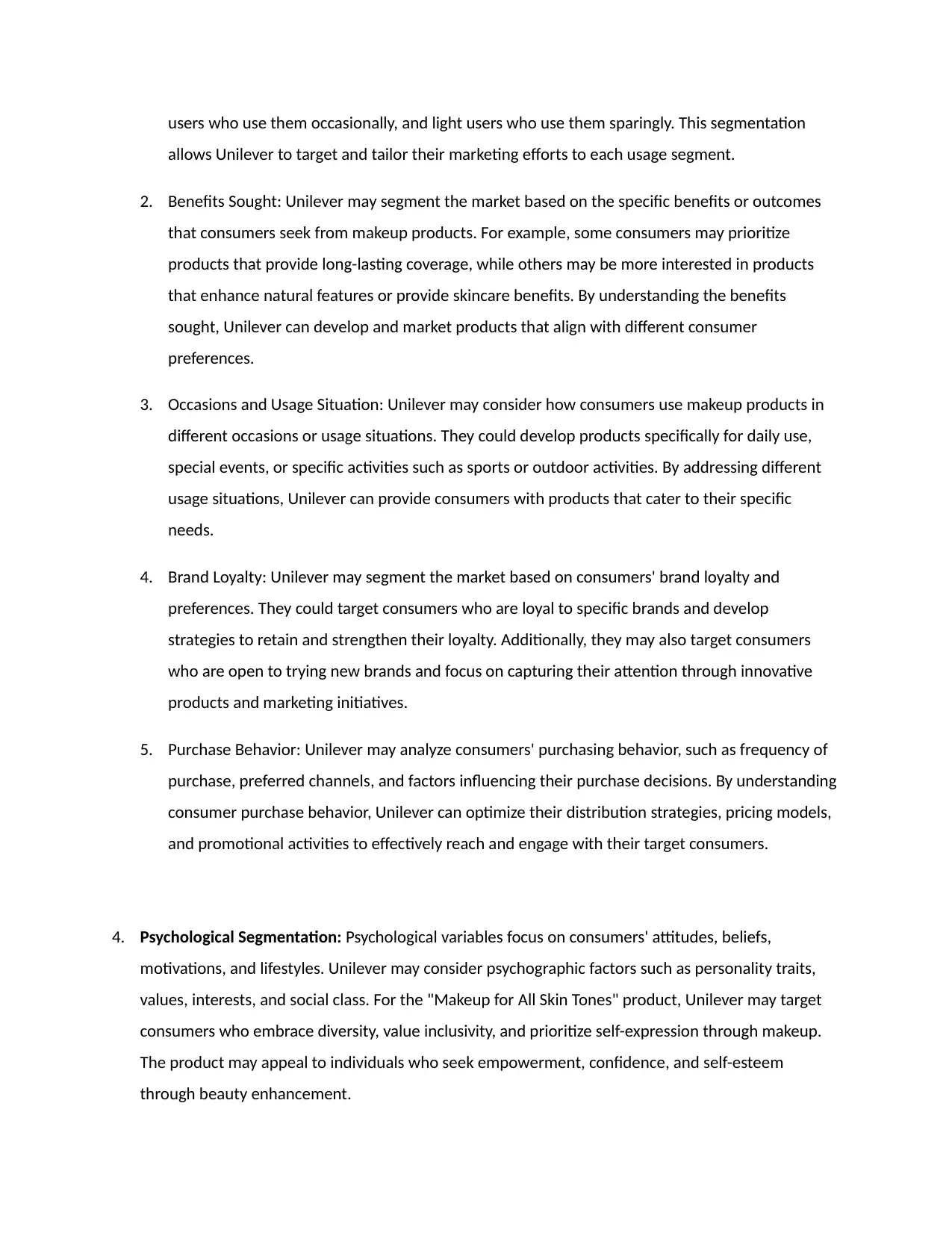
users who use them occasionally, and light users who use them sparingly. This segmentation
allows Unilever to target and tailor their marketing efforts to each usage segment.
2. Benefits Sought: Unilever may segment the market based on the specific benefits or outcomes
that consumers seek from makeup products. For example, some consumers may prioritize
products that provide long-lasting coverage, while others may be more interested in products
that enhance natural features or provide skincare benefits. By understanding the benefits
sought, Unilever can develop and market products that align with different consumer
preferences.
3. Occasions and Usage Situation: Unilever may consider how consumers use makeup products in
different occasions or usage situations. They could develop products specifically for daily use,
special events, or specific activities such as sports or outdoor activities. By addressing different
usage situations, Unilever can provide consumers with products that cater to their specific
needs.
4. Brand Loyalty: Unilever may segment the market based on consumers' brand loyalty and
preferences. They could target consumers who are loyal to specific brands and develop
strategies to retain and strengthen their loyalty. Additionally, they may also target consumers
who are open to trying new brands and focus on capturing their attention through innovative
products and marketing initiatives.
5. Purchase Behavior: Unilever may analyze consumers' purchasing behavior, such as frequency of
purchase, preferred channels, and factors influencing their purchase decisions. By understanding
consumer purchase behavior, Unilever can optimize their distribution strategies, pricing models,
and promotional activities to effectively reach and engage with their target consumers.
4. Psychological Segmentation: Psychological variables focus on consumers' attitudes, beliefs,
motivations, and lifestyles. Unilever may consider psychographic factors such as personality traits,
values, interests, and social class. For the "Makeup for All Skin Tones" product, Unilever may target
consumers who embrace diversity, value inclusivity, and prioritize self-expression through makeup.
The product may appeal to individuals who seek empowerment, confidence, and self-esteem
through beauty enhancement.
allows Unilever to target and tailor their marketing efforts to each usage segment.
2. Benefits Sought: Unilever may segment the market based on the specific benefits or outcomes
that consumers seek from makeup products. For example, some consumers may prioritize
products that provide long-lasting coverage, while others may be more interested in products
that enhance natural features or provide skincare benefits. By understanding the benefits
sought, Unilever can develop and market products that align with different consumer
preferences.
3. Occasions and Usage Situation: Unilever may consider how consumers use makeup products in
different occasions or usage situations. They could develop products specifically for daily use,
special events, or specific activities such as sports or outdoor activities. By addressing different
usage situations, Unilever can provide consumers with products that cater to their specific
needs.
4. Brand Loyalty: Unilever may segment the market based on consumers' brand loyalty and
preferences. They could target consumers who are loyal to specific brands and develop
strategies to retain and strengthen their loyalty. Additionally, they may also target consumers
who are open to trying new brands and focus on capturing their attention through innovative
products and marketing initiatives.
5. Purchase Behavior: Unilever may analyze consumers' purchasing behavior, such as frequency of
purchase, preferred channels, and factors influencing their purchase decisions. By understanding
consumer purchase behavior, Unilever can optimize their distribution strategies, pricing models,
and promotional activities to effectively reach and engage with their target consumers.
4. Psychological Segmentation: Psychological variables focus on consumers' attitudes, beliefs,
motivations, and lifestyles. Unilever may consider psychographic factors such as personality traits,
values, interests, and social class. For the "Makeup for All Skin Tones" product, Unilever may target
consumers who embrace diversity, value inclusivity, and prioritize self-expression through makeup.
The product may appeal to individuals who seek empowerment, confidence, and self-esteem
through beauty enhancement.
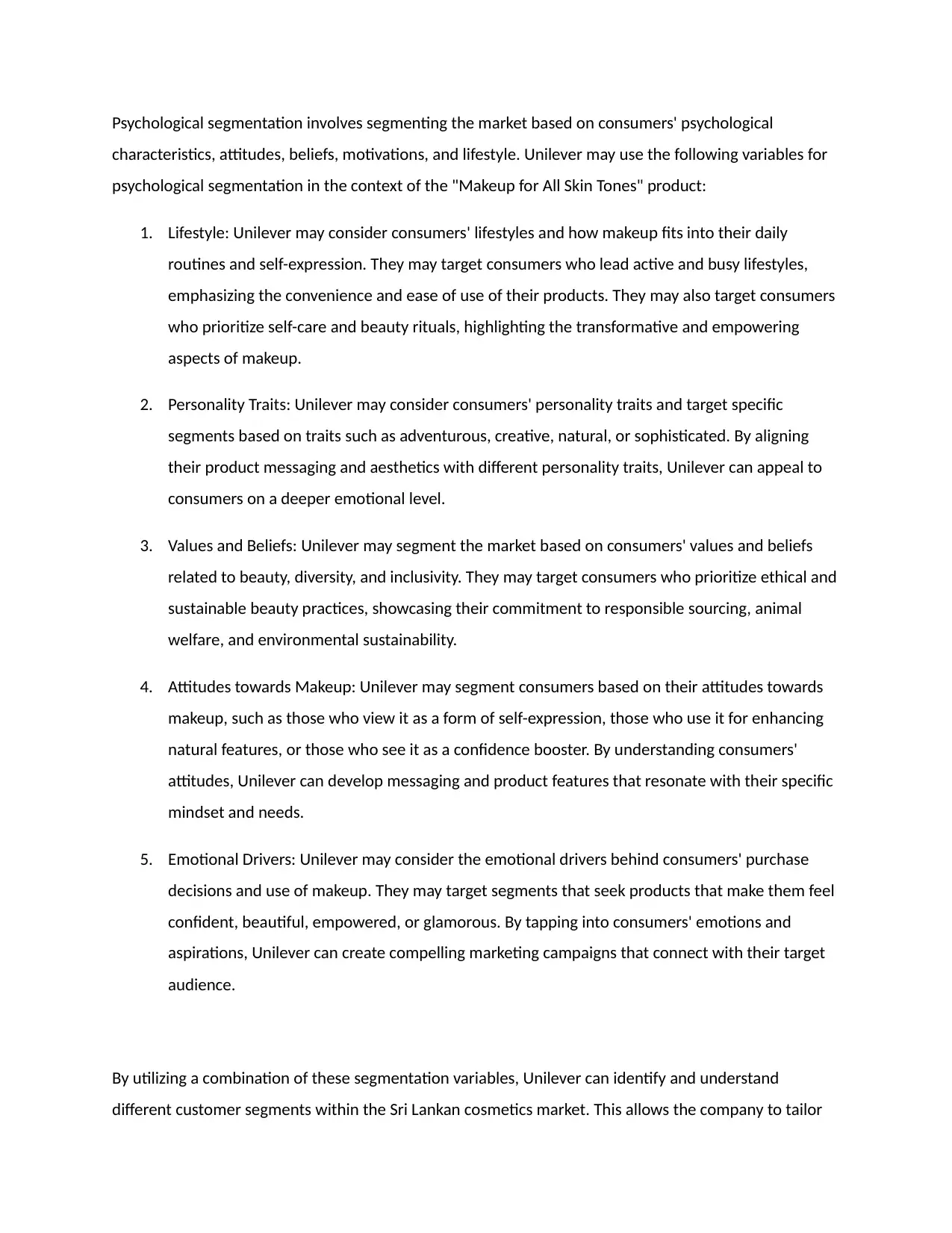
Psychological segmentation involves segmenting the market based on consumers' psychological
characteristics, attitudes, beliefs, motivations, and lifestyle. Unilever may use the following variables for
psychological segmentation in the context of the "Makeup for All Skin Tones" product:
1. Lifestyle: Unilever may consider consumers' lifestyles and how makeup fits into their daily
routines and self-expression. They may target consumers who lead active and busy lifestyles,
emphasizing the convenience and ease of use of their products. They may also target consumers
who prioritize self-care and beauty rituals, highlighting the transformative and empowering
aspects of makeup.
2. Personality Traits: Unilever may consider consumers' personality traits and target specific
segments based on traits such as adventurous, creative, natural, or sophisticated. By aligning
their product messaging and aesthetics with different personality traits, Unilever can appeal to
consumers on a deeper emotional level.
3. Values and Beliefs: Unilever may segment the market based on consumers' values and beliefs
related to beauty, diversity, and inclusivity. They may target consumers who prioritize ethical and
sustainable beauty practices, showcasing their commitment to responsible sourcing, animal
welfare, and environmental sustainability.
4. Attitudes towards Makeup: Unilever may segment consumers based on their attitudes towards
makeup, such as those who view it as a form of self-expression, those who use it for enhancing
natural features, or those who see it as a confidence booster. By understanding consumers'
attitudes, Unilever can develop messaging and product features that resonate with their specific
mindset and needs.
5. Emotional Drivers: Unilever may consider the emotional drivers behind consumers' purchase
decisions and use of makeup. They may target segments that seek products that make them feel
confident, beautiful, empowered, or glamorous. By tapping into consumers' emotions and
aspirations, Unilever can create compelling marketing campaigns that connect with their target
audience.
By utilizing a combination of these segmentation variables, Unilever can identify and understand
different customer segments within the Sri Lankan cosmetics market. This allows the company to tailor
characteristics, attitudes, beliefs, motivations, and lifestyle. Unilever may use the following variables for
psychological segmentation in the context of the "Makeup for All Skin Tones" product:
1. Lifestyle: Unilever may consider consumers' lifestyles and how makeup fits into their daily
routines and self-expression. They may target consumers who lead active and busy lifestyles,
emphasizing the convenience and ease of use of their products. They may also target consumers
who prioritize self-care and beauty rituals, highlighting the transformative and empowering
aspects of makeup.
2. Personality Traits: Unilever may consider consumers' personality traits and target specific
segments based on traits such as adventurous, creative, natural, or sophisticated. By aligning
their product messaging and aesthetics with different personality traits, Unilever can appeal to
consumers on a deeper emotional level.
3. Values and Beliefs: Unilever may segment the market based on consumers' values and beliefs
related to beauty, diversity, and inclusivity. They may target consumers who prioritize ethical and
sustainable beauty practices, showcasing their commitment to responsible sourcing, animal
welfare, and environmental sustainability.
4. Attitudes towards Makeup: Unilever may segment consumers based on their attitudes towards
makeup, such as those who view it as a form of self-expression, those who use it for enhancing
natural features, or those who see it as a confidence booster. By understanding consumers'
attitudes, Unilever can develop messaging and product features that resonate with their specific
mindset and needs.
5. Emotional Drivers: Unilever may consider the emotional drivers behind consumers' purchase
decisions and use of makeup. They may target segments that seek products that make them feel
confident, beautiful, empowered, or glamorous. By tapping into consumers' emotions and
aspirations, Unilever can create compelling marketing campaigns that connect with their target
audience.
By utilizing a combination of these segmentation variables, Unilever can identify and understand
different customer segments within the Sri Lankan cosmetics market. This allows the company to tailor
⊘ This is a preview!⊘
Do you want full access?
Subscribe today to unlock all pages.

Trusted by 1+ million students worldwide
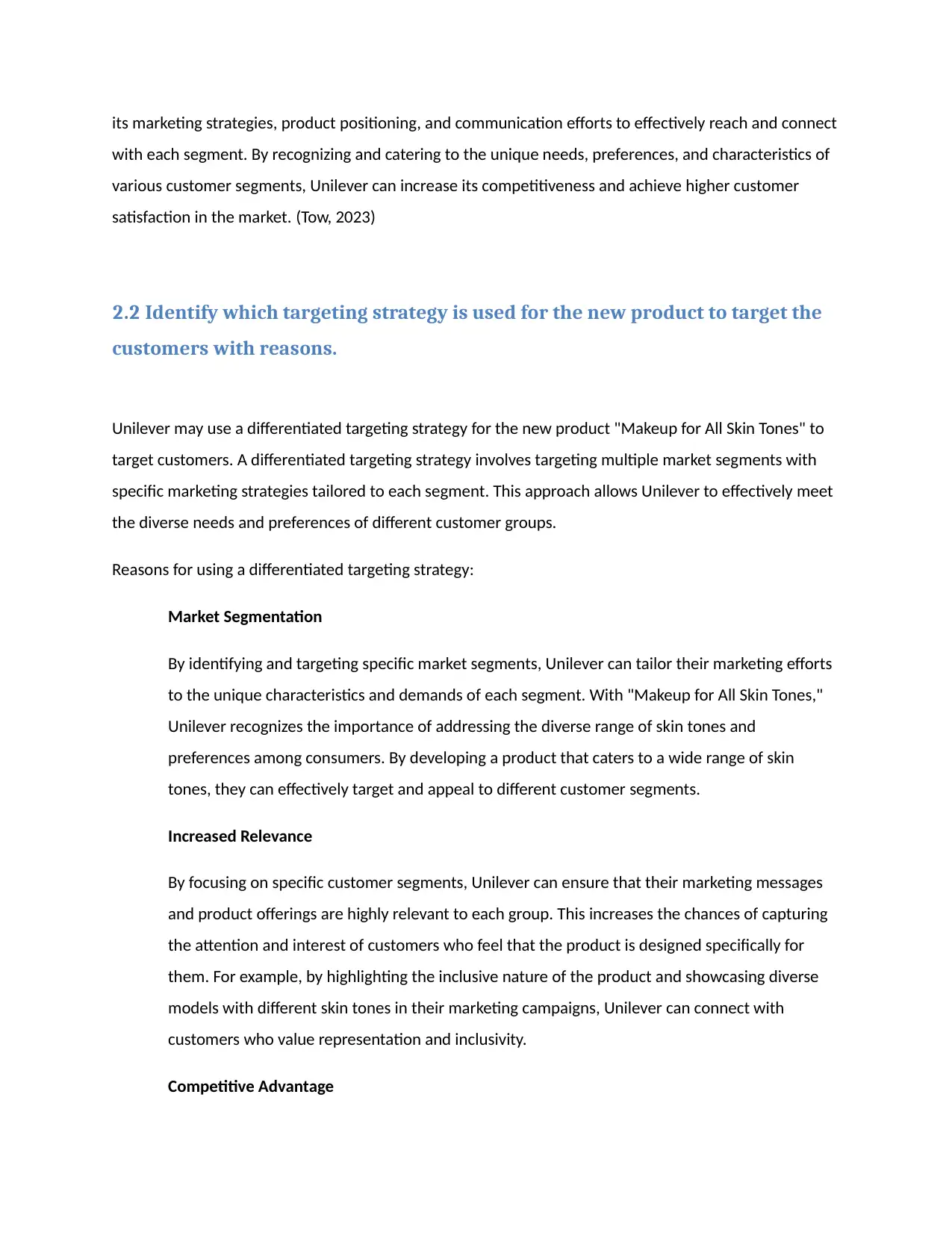
its marketing strategies, product positioning, and communication efforts to effectively reach and connect
with each segment. By recognizing and catering to the unique needs, preferences, and characteristics of
various customer segments, Unilever can increase its competitiveness and achieve higher customer
satisfaction in the market. (Tow, 2023)
2.2 Identify which targeting strategy is used for the new product to target the
customers with reasons.
Unilever may use a differentiated targeting strategy for the new product "Makeup for All Skin Tones" to
target customers. A differentiated targeting strategy involves targeting multiple market segments with
specific marketing strategies tailored to each segment. This approach allows Unilever to effectively meet
the diverse needs and preferences of different customer groups.
Reasons for using a differentiated targeting strategy:
Market Segmentation
By identifying and targeting specific market segments, Unilever can tailor their marketing efforts
to the unique characteristics and demands of each segment. With "Makeup for All Skin Tones,"
Unilever recognizes the importance of addressing the diverse range of skin tones and
preferences among consumers. By developing a product that caters to a wide range of skin
tones, they can effectively target and appeal to different customer segments.
Increased Relevance
By focusing on specific customer segments, Unilever can ensure that their marketing messages
and product offerings are highly relevant to each group. This increases the chances of capturing
the attention and interest of customers who feel that the product is designed specifically for
them. For example, by highlighting the inclusive nature of the product and showcasing diverse
models with different skin tones in their marketing campaigns, Unilever can connect with
customers who value representation and inclusivity.
Competitive Advantage
with each segment. By recognizing and catering to the unique needs, preferences, and characteristics of
various customer segments, Unilever can increase its competitiveness and achieve higher customer
satisfaction in the market. (Tow, 2023)
2.2 Identify which targeting strategy is used for the new product to target the
customers with reasons.
Unilever may use a differentiated targeting strategy for the new product "Makeup for All Skin Tones" to
target customers. A differentiated targeting strategy involves targeting multiple market segments with
specific marketing strategies tailored to each segment. This approach allows Unilever to effectively meet
the diverse needs and preferences of different customer groups.
Reasons for using a differentiated targeting strategy:
Market Segmentation
By identifying and targeting specific market segments, Unilever can tailor their marketing efforts
to the unique characteristics and demands of each segment. With "Makeup for All Skin Tones,"
Unilever recognizes the importance of addressing the diverse range of skin tones and
preferences among consumers. By developing a product that caters to a wide range of skin
tones, they can effectively target and appeal to different customer segments.
Increased Relevance
By focusing on specific customer segments, Unilever can ensure that their marketing messages
and product offerings are highly relevant to each group. This increases the chances of capturing
the attention and interest of customers who feel that the product is designed specifically for
them. For example, by highlighting the inclusive nature of the product and showcasing diverse
models with different skin tones in their marketing campaigns, Unilever can connect with
customers who value representation and inclusivity.
Competitive Advantage
Paraphrase This Document
Need a fresh take? Get an instant paraphrase of this document with our AI Paraphraser
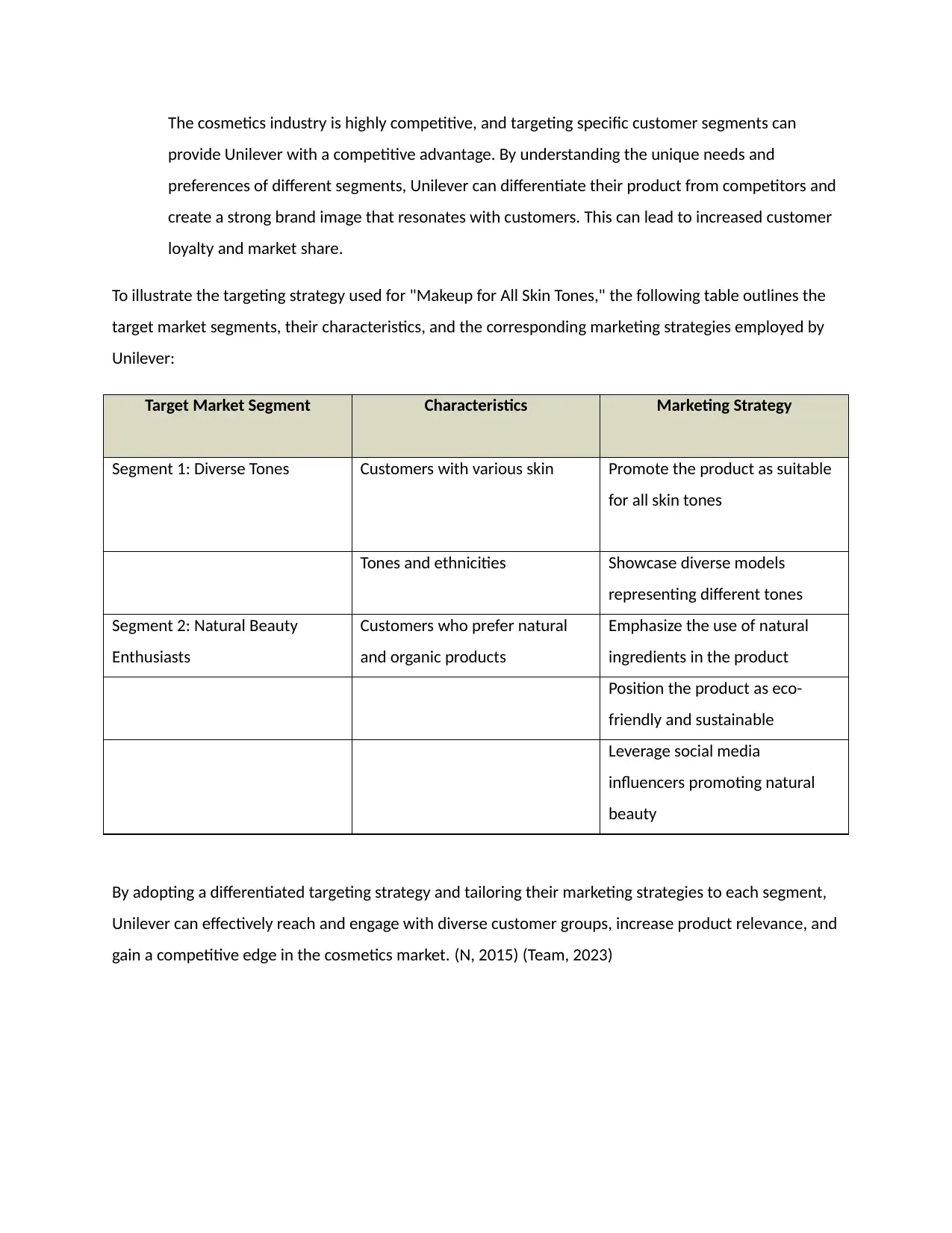
The cosmetics industry is highly competitive, and targeting specific customer segments can
provide Unilever with a competitive advantage. By understanding the unique needs and
preferences of different segments, Unilever can differentiate their product from competitors and
create a strong brand image that resonates with customers. This can lead to increased customer
loyalty and market share.
To illustrate the targeting strategy used for "Makeup for All Skin Tones," the following table outlines the
target market segments, their characteristics, and the corresponding marketing strategies employed by
Unilever:
Target Market Segment Characteristics Marketing Strategy
Segment 1: Diverse Tones Customers with various skin Promote the product as suitable
for all skin tones
Tones and ethnicities Showcase diverse models
representing different tones
Segment 2: Natural Beauty
Enthusiasts
Customers who prefer natural
and organic products
Emphasize the use of natural
ingredients in the product
Position the product as eco-
friendly and sustainable
Leverage social media
influencers promoting natural
beauty
By adopting a differentiated targeting strategy and tailoring their marketing strategies to each segment,
Unilever can effectively reach and engage with diverse customer groups, increase product relevance, and
gain a competitive edge in the cosmetics market. (N, 2015) (Team, 2023)
provide Unilever with a competitive advantage. By understanding the unique needs and
preferences of different segments, Unilever can differentiate their product from competitors and
create a strong brand image that resonates with customers. This can lead to increased customer
loyalty and market share.
To illustrate the targeting strategy used for "Makeup for All Skin Tones," the following table outlines the
target market segments, their characteristics, and the corresponding marketing strategies employed by
Unilever:
Target Market Segment Characteristics Marketing Strategy
Segment 1: Diverse Tones Customers with various skin Promote the product as suitable
for all skin tones
Tones and ethnicities Showcase diverse models
representing different tones
Segment 2: Natural Beauty
Enthusiasts
Customers who prefer natural
and organic products
Emphasize the use of natural
ingredients in the product
Position the product as eco-
friendly and sustainable
Leverage social media
influencers promoting natural
beauty
By adopting a differentiated targeting strategy and tailoring their marketing strategies to each segment,
Unilever can effectively reach and engage with diverse customer groups, increase product relevance, and
gain a competitive edge in the cosmetics market. (N, 2015) (Team, 2023)
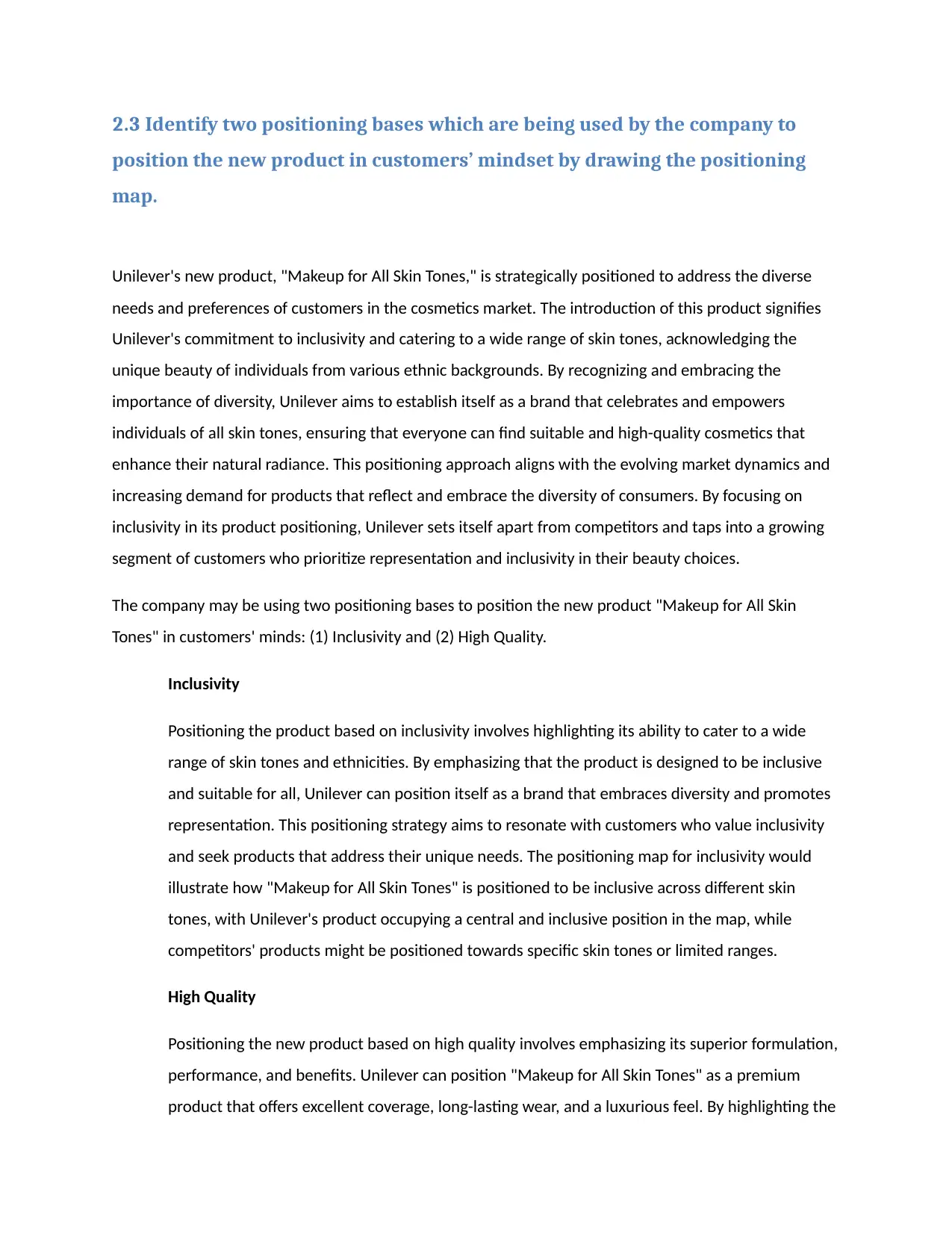
2.3 Identify two positioning bases which are being used by the company to
position the new product in customers’ mindset by drawing the positioning
map.
Unilever's new product, "Makeup for All Skin Tones," is strategically positioned to address the diverse
needs and preferences of customers in the cosmetics market. The introduction of this product signifies
Unilever's commitment to inclusivity and catering to a wide range of skin tones, acknowledging the
unique beauty of individuals from various ethnic backgrounds. By recognizing and embracing the
importance of diversity, Unilever aims to establish itself as a brand that celebrates and empowers
individuals of all skin tones, ensuring that everyone can find suitable and high-quality cosmetics that
enhance their natural radiance. This positioning approach aligns with the evolving market dynamics and
increasing demand for products that reflect and embrace the diversity of consumers. By focusing on
inclusivity in its product positioning, Unilever sets itself apart from competitors and taps into a growing
segment of customers who prioritize representation and inclusivity in their beauty choices.
The company may be using two positioning bases to position the new product "Makeup for All Skin
Tones" in customers' minds: (1) Inclusivity and (2) High Quality.
Inclusivity
Positioning the product based on inclusivity involves highlighting its ability to cater to a wide
range of skin tones and ethnicities. By emphasizing that the product is designed to be inclusive
and suitable for all, Unilever can position itself as a brand that embraces diversity and promotes
representation. This positioning strategy aims to resonate with customers who value inclusivity
and seek products that address their unique needs. The positioning map for inclusivity would
illustrate how "Makeup for All Skin Tones" is positioned to be inclusive across different skin
tones, with Unilever's product occupying a central and inclusive position in the map, while
competitors' products might be positioned towards specific skin tones or limited ranges.
High Quality
Positioning the new product based on high quality involves emphasizing its superior formulation,
performance, and benefits. Unilever can position "Makeup for All Skin Tones" as a premium
product that offers excellent coverage, long-lasting wear, and a luxurious feel. By highlighting the
position the new product in customers’ mindset by drawing the positioning
map.
Unilever's new product, "Makeup for All Skin Tones," is strategically positioned to address the diverse
needs and preferences of customers in the cosmetics market. The introduction of this product signifies
Unilever's commitment to inclusivity and catering to a wide range of skin tones, acknowledging the
unique beauty of individuals from various ethnic backgrounds. By recognizing and embracing the
importance of diversity, Unilever aims to establish itself as a brand that celebrates and empowers
individuals of all skin tones, ensuring that everyone can find suitable and high-quality cosmetics that
enhance their natural radiance. This positioning approach aligns with the evolving market dynamics and
increasing demand for products that reflect and embrace the diversity of consumers. By focusing on
inclusivity in its product positioning, Unilever sets itself apart from competitors and taps into a growing
segment of customers who prioritize representation and inclusivity in their beauty choices.
The company may be using two positioning bases to position the new product "Makeup for All Skin
Tones" in customers' minds: (1) Inclusivity and (2) High Quality.
Inclusivity
Positioning the product based on inclusivity involves highlighting its ability to cater to a wide
range of skin tones and ethnicities. By emphasizing that the product is designed to be inclusive
and suitable for all, Unilever can position itself as a brand that embraces diversity and promotes
representation. This positioning strategy aims to resonate with customers who value inclusivity
and seek products that address their unique needs. The positioning map for inclusivity would
illustrate how "Makeup for All Skin Tones" is positioned to be inclusive across different skin
tones, with Unilever's product occupying a central and inclusive position in the map, while
competitors' products might be positioned towards specific skin tones or limited ranges.
High Quality
Positioning the new product based on high quality involves emphasizing its superior formulation,
performance, and benefits. Unilever can position "Makeup for All Skin Tones" as a premium
product that offers excellent coverage, long-lasting wear, and a luxurious feel. By highlighting the
⊘ This is a preview!⊘
Do you want full access?
Subscribe today to unlock all pages.

Trusted by 1+ million students worldwide
1 out of 23
Related Documents
Your All-in-One AI-Powered Toolkit for Academic Success.
+13062052269
info@desklib.com
Available 24*7 on WhatsApp / Email
![[object Object]](/_next/static/media/star-bottom.7253800d.svg)
Unlock your academic potential
Copyright © 2020–2025 A2Z Services. All Rights Reserved. Developed and managed by ZUCOL.





